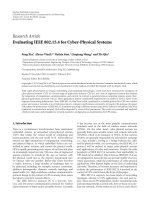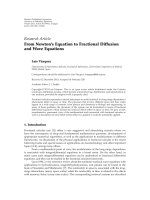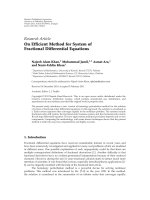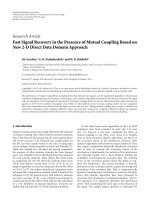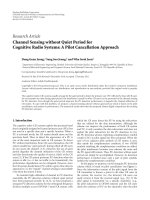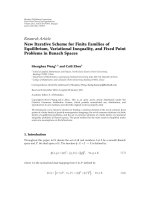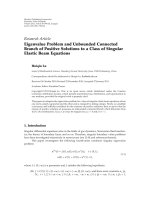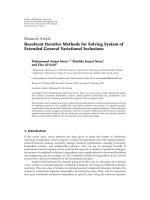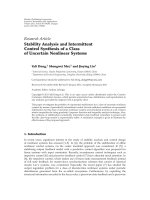Báo cáo hóa học: " Research Article Nonexpansive Matrices with Applications to Solutions of Linear Systems by Fixed Point Iterations Teck-Cheong Lim" docx
Bạn đang xem bản rút gọn của tài liệu. Xem và tải ngay bản đầy đủ của tài liệu tại đây (510.02 KB, 13 trang )
Hindawi Publishing Corporation
Fixed Point Theory and Applications
Volume 2010, Article ID 821928, 13 pages
doi:10.1155/2010/821928
Research Article
Nonexpansive Matrices with Applications
to Solutions of Linear Systems by Fixed
Point Iterations
Teck-Cheong Lim
Department of Mathematical Sciences, George Mason University, 4400, University Drive,
Fairfax, VA 22030, USA
Correspondence should be addressed to Teck-Cheong Lim,
Received 28 August 2009; Accepted 19 October 2009
Academic Editor: Mohamed A. Khamsi
Copyright q 2010 Teck-Cheong Lim. This is an open access article distributed under the Creative
Commons Attribution License, which permits unrestricted use, distribution, and reproduction in
any medium, provided the original work is properly cited.
We characterize i matrices which are nonexpansive with respect to some matrix norms, and ii
matrices whose average iterates approach zero or are bounded. Then we apply these results to
iterative solutions of a system of linear equations.
Throughout this paper, R will denote the set of real numbers, C the set of complex numbers,
and M
n
the complex vector space of complex n × n matrices. A function ·: M
n
→ R is a
matrix norm if for all A, B ∈ M
n
, it satisfies the following five axioms:
1 A≥0;
2 A 0 if and only if A 0;
3 cA |c|A for all complex scalars c;
4 A B≤A B;
5 AB≤AB.
Let |·|be a norm on C
n
. Define ·on M
n
by
A
max
|
x
|
1
|
Ax
|
.
1
This norm on M
n
is a matrix norm, called the matrix norm induced by |·|. A matrix norm on
M
n
is called an induced matrix norm if it is induced by some norm on C
n
.If·
1
is a matrix
norm on M
n
, there exists an induced matrix norm ·
2
on M
n
such that A
2
≤A
1
for all
2 Fixed Point Theory and Applications
A ∈ M
n
cf. 1, page 297. Indeed one can take ·
2
to be the matrix norm induced by the
norm |·|on C
n
defined by
|
x
|
Cx
1
, 2
where Cx is the matrix in M
n
whose columns are all equal to x. For A ∈ M
n
, ρA denotes
the spectral radius of A.
Let |·|be a norm in C
n
. A matrix A ∈ M
n
is a contraction relative to |·|if it is a
contraction as a transformation from C
n
into C
n
; that is, there exists 0 ≤ λ<1 such that
Ax − Ay
≤ λ
x − y
,x,y∈ C
n
. 3
Evidently this means that for the matrix norm ·induced by |·|, A < 1. The following
theorem is well known cf. 1, Sections 5.6.9–5.6.12.
Theorem 1. For a matrix A ∈ M
n
, the following are equivalent:
a A is a contraction relative to a norm in C
n
;
b A < 1 for s ome induced matrix norm ·;
c A < 1 for s ome matrix norm ·;
d lim
k →∞
A
k
0;
e ρA < 1.
That b follows from c is a consequence of the previous remark about an induced matrix
norm being less than a matrix norm. Since all norms on M
n
are equivalent, the limit in d
can be relative to any norm on M
n
,sothatd is equivalent to all the entries of A
k
converge
to zero as k →∞, which in turn is equivalent to lim
k →∞
A
k
x 0 for all x ∈ C
n
.
In this paper, we first characterize matrices in M
n
that are nonexpansive relative to some
norm |·|on C
n
,thatis,
Ax − Ay
≤
x − y
,x,y∈ C
n
. 4
Then we characterize those A ∈ M
n
such that
A
k
1
k
I A A
2
··· A
k−1
5
converges to zero as k →∞, and those that {A
k
: k 0, 1, 2, } is bounded.
Finally we apply our theory to approximation of solution of Ax b using iterative
methods fixed point iteration methods.
Fixed Point Theory and Applications 3
Theorem 2. For a matrix A ∈ M
n
, the following are equivalent:
a A is nonexpansive relative to some norm on C
n
;
b A≤1 for some induced matrix norm ·;
c A≤1 for some matrix norm ·;
d {A
k
: k 0, 1, 2, } is bounded;
e ρA ≤ 1, and for any eigenvalue λ of A with |λ| 1, the geometric multiplicity is equal to
the algebraic multiplicity.
Proof. As in the previous theorem, a, b,andc are equivalent. Assume that b holds. Let
the norm ·be induced by a vector norm |·|of C
n
. Then
A
k
x
≤
A
k
|
x
|
≤
A
k
|
x
|
≤
|
x
|
,k 0, 1, 2, , 6
proving that A
k
x is bounded in norm |·|for every x ∈ C
n
. Taking x e
i
, we see that the set
of all columns of A
k
,k 0, 1, 2, ,is bounded. This proves that A
k
,k 0, 1, 2, ,is bounded
in maximum column sum matrix norm 1, page 294, and hence in any norm in M
n
.Note
that the last part of the proof also follows from the Uniform Boundedness Principle see, e.g.,
2, Corollary 21, page 66
Now we prove that d implies e. Suppose that A has an eigenvalue λ with λ>1.
Let x be an eigenvector corresponding to λ. Then
A
k
x
|
λ
|
k
x
−→ ∞ 7
as k →∞, where ·is any vector norm of C
n
. This contradicts d. Hence |λ|≤1. Now
suppose that λ is an eigenvalue with |λ| 1 and the Jordan block corresponding to λ is not
diagonal. T hen there exist nonzero vectors v
1
,v
2
such that Av
1
λv
1
,Av
2
v
1
λv
2
.Let
u v
1
v
2
. Then
A
k
u λ
k−1
λ k
v
1
λ
k
v
2
,
8
and A
k
u≥kv
1
−v
1
−v
2
. It follows that A
k
u, k 0, 1, 2, , is unbounded,
contradicting d. Hence d implies e.
Lastly we prove that e implies c. Assume that e holds. A is similar to its Jordan
canonical form J whose nonzero off-diagonal entries can be made arbitrarily small by
similarity 1, page 128. Since the Jordan block for each eigenvalue with modulus 1 is
diagonal, we see that there is an invertible matrix S such that the l
1
-sum of each row of
SAS
−1
is less than or equal to 1, that is, SAS
−1
∞
≤ 1, where ·
∞
is the maximum row sum
matrix norm 1, page 295. Define a matrix norm ·by M SMS
−1
∞
. Then we have
A≤1.
Let λ be an eigenvalue of a matrix A ∈ M
n
.Theindexofλ, denoted by indexλ is the
smallest value of k for which rankA − λI
k
rankA − λI
k1
1, pages 148 and 131.Thus
condition e above can be restated as ρA ≤ 1, and for any eigenvalue λ of A with |λ| 1,
indexλ1.
4 Fixed Point Theory and Applications
Let A ∈ M
n
. Consider
A
k
1
k
I A ··· A
k−1
.
9
We call A
k
the k-average of A.AswithA
k
, we have A
k
x → 0 for every x if and only if
A
k
→ 0inM
n
,andthatA
k
x is bounded for every x if and only if A
k
is bounded in M
n
.We
have the following theorem.
Theorem 3. Let A ∈ M
n
.Then
a A
k
,k 1, 2, ,converges to 0 if and only if A≤1 for some matrix norm ·and that
1 is not an eigenvalue of A,
b A
k
,k 1, 2, ,is bounded if and only if ρA ≤ 1, indexλ ≤ 2 for every eigenvalue λ
with |λ| 1 and that index11 if 1 is an eigenvalue of A.
Proof. First we prove the sufficiency part of a.Letx be a vector in C
n
.Let
y
k
1
k
I A ··· A
k−1
x
.
10
By Theorem 2 for any eigenvalues λ of A either |λ| < 1or|λ| 1andindexλ1.
If A is written in its Jordan canonical form A SJS
−1
, then the k-average of A is
SJ
S
−1
, where J
is the k-average of J. J
is in turn composed of the k-average of each of its
Jordan blocks. For a Jordan block of J of the form
⎛
⎜
⎜
⎜
⎜
⎜
⎜
⎝
λ 1
λ 1
··
· 1
λ
⎞
⎟
⎟
⎟
⎟
⎟
⎟
⎠
, 11
|λ| must be less than 1. Its k-average has constant diagonal and upper diagonals. Let D
j
be
the constat value of its jth upper diagonal D
0
being the diagonal and let S
j
kD
j
. Then
Cm, n0forn>m
S
0
1 − λ
k
1 − λ
,
S
j
C
j, j
C
j 1,j
λ ··· C
k − 1,j
λ
k−1−j
,j 1, 2, ,n− 1.
12
Using the relation Cm 1,j − Cm, jCm, j − 1,weobtain
S
j
− λS
j
S
j−1
− λ
k−j
C
k, j
.
13
Thus, we have S
0
→ 1/1 − λ as k →∞. By induction, using 13 above and the fact that
λ
k−j
Ck, j → 0ask →∞,weobtainS
j
→ 1/1 − λ
j1
as k →∞. Therefore D
j
S
j
/k
O1/k as k →∞.
Fixed Point Theory and Applications 5
If the Jordan block is diagonal of constant value λ, then λ
/
1, |λ|≤1andthek-average
of the block is diagonal of constant value 1 − λ
k
/k1 − λO1/k.
We conclude that A
k
O1/k and hence y
k
≤A
k
x O1/k as k →∞.
Now we prove the necessity part of a. If 1 is an eigenvalue of A and x is a
corresponding eigenvector, then A
k
x x
/
0 for every k and of course B
k
x fails to converge
to 0. If λ is an eigenvalue of A with |λ| > 1andx is a corresponding eigenvector, then
A
k
x
λ
k
− 1
k
λ − 1
x
≥
|
λ
|
k
− 1
k
|
λ − 1
|
x
. 14
which approaches to ∞ as k →∞.Ifλ is an eigenvalue of A with |λ| 1,λ
/
1, and
indexλ ≥ 2, then there exist nonzero vectors v
1
,v
2
such that Av
1
λv
1
,Av
2
v
1
λv
2
.
Then by using the identity
1 2λ 3λ
2
···
k − 1
λ
k−2
1 − λ
k−1
1 − λ
2
−
k − 1
λ
k−1
1 − λ
15
we get
A
k
v
2
1 − λ
k−1
k
1 − λ
2
−
1 −
1
k
λ
k−1
1 − λ
v
1
1 − λ
k
k
1 − λ
v
2
. 16
It follows that lim
k →∞
A
k
v
2
does not exist. This completes t he proof of part a.
Suppose that A satisfies the conditions in b and that A SJS
−1
is the Jordan
canonical form of A.Letλ be an eigenvalue of A and let v be a column vector of S
corresponding to λ.If|λ| < 1, then the restriction B of A to the subspace spanned by
v, Av,A
2
v, is a contraction, and we have A
k
v B
k
v≤v.If|λ| 1, and λ
/
1,
then by conditions in b either Av λv, or there exist v
1
,v
2
with v v
2
such that
Av
1
λv
1
,Av
2
v
1
λv
2
. In the former case, we have A
k
≤v and in the latter case,
we see from 16 that A
k
vA
k
v
2
is bounded. Finally if λ 1 then since index11, we
have Av v and hence A
k
v v. In all cases, we proved that A
k
v, k 0, 1, 2, ,is bounded.
Since column vectors of S formabasisforC
n
,thesufficiency part of b follows.
Now we prove the necessity part of b.IfA has an eigenvalue λ with |λ| > 1and
eigenvector v, then as shown above A
k
v →∞as k →∞.IfA has 1 as an eigenvalue and
index1 ≥ 2, then there exist nonzero vectors v
1
,v
2
such that Av
1
v
1
and Av
2
v
1
v
2
.
Then A
k
v
2
k−1/2v
2
which is unbounded. If λ is an eigenvalue of A with |λ| 1,λ
/
1
and indexλ ≥ 3, then there exist nonzero vectors v
1
,v
2
and v
3
such that Av
1
λv
1
,Av
2
v
1
λv
2
and Av
3
v
2
λv
3
. By expanding A
j
v
3
,j 0, 1, 2, ,k− 1 and using the identity
k−1
j2
C
j, 2
λ
j−2
1
1 − λ
2
1 − λ
k−2
1 − λ
1
2
k − 2
λ
k−2
k − 1
λ −
k 1
,
17
6 Fixed Point Theory and Applications
we obtain
A
k
v
3
1
1 − λ
2
1 − λ
k−2
k
1 − λ
1
2
k − 2
λ
k−2
k − 1
k
λ −
k 1
k
v
1
1 − λ
k−1
k
1 − λ
2
−
1 −
1
k
λ
k−1
1 − λ
v
2
1 − λ
k
k
1 − λ
v
3
18
which approaches to ∞ as k →∞. T his completes the proof.
We now consider applications of preceding theorems to approximation of solution of
a linear system Ax b, where A ∈ M
n
and b a given vector in C
n
.LetQ be a given invertible
matrix in M
n
. x is a solution of Ax b if and only if x is a fixed point of the mapping T
defined by
Tx
I − Q
−1
A
x Q
−1
b. 19
T is a contraction if and only if I − Q
−1
A is. In this case, by the well known Contraction
Mapping Theorem, given any initial vector x
0
, the sequence of iterates x
k
T
k
x
0
,k
0, 1, 2, , converges to the unique solution of Ax b. In practice, given x
0
, each successive
x
k
is obtained from x
k−1
by solving the equation
Q
x
k
Q − A
x
k−1
b. 20
The classical methods of Richardson, Jacobi, and Gauss-Seidel see, e.g., 3 have Q I, D,
and L respectively, where I is the identity matrix, D the diagonal matrix containing the
diagonal of A,andL the lower triangular matrix containing the lower triangular portion
of A.ThusbyTheorem 1 we have the following known theorem.
Theorem 4. Let A, Q ∈ M
n
,withQ invertible. Let b, x
0
∈ C
n
.IfρI − Q
−1
A < 1,thenA is
invertible and the sequence x
k
,k 1, 2, ,defined recursively by
Q
x
k
Q − A
x
k−1
b 21
converges to the unique solution of Ax b.
Theorem 4 fails if ρI − Q
−1
A1, For a simple 2 × 2 example, let Q I, b 0,A 2I
and x
0
any nonzero vector.
We need the following lemma in the proof of the next two theorems. For a matrix
A ∈ M
n
, we will denote RA and NA the range and the null space of A respectively.
Lemma 5. Let A be a s ingular matrix in M
n
such that the geometric multiplicity and the algebraic
multiplicity of the eigenvalue 0 are equal, that is, index01. Then there is a unique projection
P
A
whose range is the range of A and whose null space is the null space of A, or equivalently, C
n
RA ⊕ NA. Moreover, A restricted to RA is an invertible transformation from RA onto RA.
Fixed Point Theory and Applications 7
Proof. If A SJS
−1
is a Jordan canonical form of A where the eigenvalues 0 appear at the end
portion of the diagonal of J, then the matrix
P
A
S
⎡
⎢
⎢
⎢
⎢
⎢
⎢
⎢
⎢
⎢
⎢
⎢
⎢
⎢
⎢
⎢
⎢
⎢
⎣
1
·
·
1
0
·
·
0
⎤
⎥
⎥
⎥
⎥
⎥
⎥
⎥
⎥
⎥
⎥
⎥
⎥
⎥
⎥
⎥
⎥
⎥
⎦
S
−1
22
is the required projection. Obviously A maps RA into RA.Ifz ∈ RA and Az 0, then
z ∈ NA ∩ RA{0} and so z 0. This proves that A is invertible on RA.
Remark 6. Under the assumptions of Lemma 5, we will call the component of a vector c in
NA the projection of c on NA along RA. Note that by definition of index, the condition
in the lemma is equivalent to NA
2
NA.
Theorem 7. Let A be a matrix in M
n
and b a vector in C
n
.LetQ be an invertible matrix in M
n
and
let B I − Q
−1
A. Assume that ρB ≤ 1 and that indexλ1 for every eigenvalue λ of B with
modulus 1, that is, B is nonexpansive relative to a matrix norm. Starting with an initial vector x
0
in
C
n
define x
k
recursively by
Q
x
k
Q − A
x
k−1
b 23
for k 1, 2, Let
y
k
x
0
x
1
··· x
k−1
k
.
24
If Ax b is consistent, that is, has a solution, then y
k
,k 1, 2, ,converge to a solution vector z
with rate of convergence y
k
− z O1/k.IfAx b is inconsistent, then lim
k
x
k
lim
k
y
k
∞. More precisely, lim
k
x
k
/k c
and lim
k
y
k
/k c
/2,wherec Q
−1
b and c
is the projection of c
on NANQ
−1
A along RQ
−1
A.
Proof. First we assume that A is invertible so that I − B Q
−1
A is also invertible. Let T be the
mapping defined by Tx Bxc. Then T
k
x B
k
xcBc···B
k−1
c.Lets cBc···B
k−1
c.
Then s − Bs c − B
k
c and hence s I − B
−1
c − I − B
−1
B
k
c I − B
−1
c − B
k
I − B
−1
c.Let
z I − B
−1
c A
−1
b. z is the unique solution of Ax b and
T
k
x B
k
x z − B
k
z B
k
x − z
z.
25
8 Fixed Point Theory and Applications
Since the sequence x
k
in the theorem is T
k
x
0
, we have
y
k
1
k
I B ··· B
k−1
x
0
− z
z B
k
x
0
− z
z.
26
Since I − B is invertible, 1 is not an eigenvalue of B,andbyTheorem 3 part a y
k
− z
B
k
x
0
−z→0ask →∞. Moreover, from the proof of the same theorem, y
k
−z O1/k.
Next we consider the case when A is not invertible. Since Q is invertible, we have
RQ
−1
AQ
−1
RA and NQ
−1
ANA. The index of the eigenvalue 0 of Q
−1
A is the
index of eigenvalue 1 of B I − Q
−1
A.ThusbyLemma 5, C
n
Q
−1
RA ⊕ NA. For every
vector v ∈ C
n
,letv
r
and v
n
denote the component of v in the subspace Q
−1
RA and
NA, respectively.
Assume that Ax b is consistent, that is, b ∈ RA. Then c ∈ RQ
−1
A.ByLemma 5,
the restriction of Q
−1
A on its range is invertible, so there exists a unique z
in RQ
−1
A such
that Q
−1
Az
c, or equivalently, I − Bz
c. For any vector x, we have
T
k
x B
k
x c Bc ··· B
k−1
c
B
K
x
r
x
n
I B ··· B
k−1
I − B
z
B
k
x
r
x
n
z
− B
k
z
B
k
x
r
− z
x
n
z
.
27
Since B maps RQ
−1
A into RQ
−1
A and I − B Q
−1
A restricted to RQ
−1
A is invertible, we
can apply the preceding proof and conclude that the sequence y
k
as defined before converges
to z x
n
0
z
and y
k
− z O1/k.NowAz Ax
n
0
Az
Az
Qc b, showing
that z is a solution of Ax b.
Assume now that b
/
∈ RA,thatis,Ax b is inconsistent. Then c
/
∈ RQ
−1
A and c
c
r
c
n
with c
n
/
0. As in the preceding case there exists a unique z
∈ RQ
−1
A such that
I − Bz
c
r
. Note that for all y ∈ NA, ByI − Q
−1
Ayy. Thus for any vector x
and any positive integer j
x
j
T
j
x
B
j
x c Bc ··· B
j−1
c
B
j
x
r
x
n
I B ··· B
j−1
I − B
z
jc
n
B
j
x
r
x
n
z
− B
j
z
jc
n
B
j
x
r
− z
x
n
z
jc
n
,
y
k
1
k
x Tx ··· T
k−1
x
B
k
x
r
− z
x
n
z
k − 1
2
c
n
,
28
Fixed Point Theory and Applications 9
where B
k
I B ··· B
k−1
. As in the preceding case, B
k
x
r
− z
,k 0, 1, 2, is bounded
and B
k
x
r
−z
,k 1, 2, ,converges to 0. Thus lim
k →∞
x
k
/kcn and lim
k →∞
y
k
/k
c
n
/2, and hence lim
k →∞
x
k
lim
k →∞
y
k
∞. This completes the proof.
Next we consider another kind of iteration in which the nonlinear case was considered
in Ishikawa 4. Note that the type of mappings in this case is slightly weaker than
nonexpansivity see condition c in the next lemma.
Lemma 8. Let B be an n × n matrix. The following are equivalent:
a for every 0 <μ<1, there exists a matrix norm ·
μ
such that μI 1 − μB
μ
≤ 1,
b for every 0 <μ<1, there exists an induced matrix norm ·
μ
such that μI1−μB
μ
≤ 1,
c ρB ≤ 1 and index11 if 1 is an eigenvalue of B.
Proof. As in the proof of Theorem 2, a and b are equivalent. For 0 <μ<1, denote μI
1 − μB by Bμ. Suppose now that a holds. Let λ be an eigenvalue of B. Then μ 1 −
μλ is an eigenvalue of Bμ.ByTheorem 2 |μ 1 − μλ|≤1 for every 0 <μ<1and
hence |λ|≤1. If 1 is an eigenvalue of B, then it is also an eigenvalue of Bμ.ByTheorem 2,
the index of 1, as an eigenvalue of B
μ, is 1. Since obviously B and Bμ have the same
eigenvectors corresponding to the eigenvalue 1, the index of 1, as an eigenvalue of B,isalso
1. This proves c.
Now assume c holds. Since |μ 1 − μλ| < 1for|λ| 1,λ
/
1, every eigenvalue of
Bμ, except possibly for 1, has modulus less than 1. Reasoning as above, if 1 is an eigenvalue
of Bμ, then its index is 1. Therefore by Theorem 2, a holds. This completes the proof.
Theorem 9. Let A ∈ M
n
and b ∈ C
n
.LetQ be an invertible matrix in M
n
, and B I − Q
−1
A.
Suppose ρB ≤ 1 and that index11 if 1 is an eigenvalue of B.Let0 <μ<1 be fixed. Starting
with an initial vector x
0
, define x
k
,y
k
,k 0, 1, 2, ,recursively by
y
0
x
0
,
Q
x
k
Q − A
y
k−1
b,
y
k
μy
k−1
1 − μ
x
k
.
29
If Ax b is consistent, then y
k
,k 0, 1, 2, ,converges to a solution vector z of Ax b with rate
of convergence given by
y
k
− z
o
ζ
k
, 30
where ζ is any number satisfying
max
μ
1 − μ
λ
: λ an eigenvalue of B, λ
/
1
<ζ<1. 31
10 Fixed Point Theory and Applications
If Ax b is inconsistent, then lim
k →∞
y
k
∞; more precisely,
lim
k →∞
y
k
k
1 − μ
c
n
,
32
where c
n
is the projection of c on NA along RQ
−1
A.
Proof. Let c Q
−1
b, B
1
μI 1 − μB I − 1 − μQ
−1
A,andTx B
1
x 1 − μc. Then
y
k
T
k
x
0
.
First we assume that A is invertible. Then I − B
1
1 − μQ
−1
A is invertible and 1 is
not an eigenvalue of B
1
;thusρB
1
< 1. Let z 1 − μI − B
1
−1
c A
−1
b. We have
y
k
T
k
x
0
B
k
1
x
0
1 − μ
c B
1
c ··· B
k−1
1
c
B
k
1
x
0
1 − μ
1
1 − μ
I B
1
··· B
k−1
1
I − B
1
z
B
k
1
x
0
− z
z.
33
By a well known theorem see, e.g. 1, y
k
− z oζ
k
for every ζ>ρB
1
.
Assume now that A is not invertible and b ∈ RA. Then c is in the range of Q
−1
A.
Since B I − Q
−1
A satisfies the condition in Lemma 8, Q
−1
A satisfies the condition in
Lemma 5. Thus the restriction of Q
−1
A on its range is invertible and there exists z
in RQ
−1
A
such that Q
−1
Az
c, or equivalently, I − B
1
z
1 − μc. For any vector x x
0
,we
have
y
k
T
k
x
B
k
1
x
1 − μ
c B
1
c ··· B
k−1
1
c
B
k
1
x
r
x
n
I B
1
··· B
k−1
1
I − B
1
z
B
k
1
x
r
x
n
z
− B
k
1
z
B
k
1
x
r
− z
x
n
z
.
34
Since B
1
maps RQ
−1
A into RQ
−1
A and I − B Q
−1
A restricted to RQ
−1
A is invertible,
we can apply the preceding proof and conclude that the sequence y
k
,k 0, 1, 2, converges
to z x
n
z
and y
k
− z oζ
k
. z solves Ax b since Az Ax
n
Az
Az
Qc b.
Fixed Point Theory and Applications 11
Assume lastly that b
/
∈ RA,thatis,Ax b is inconsistent. Then c
/
∈ RQ
−1
A and
c c
r
c
n
with c
n
/
0. As before there exists z
∈ RQ
−1
A such that I − b
1
z
1 − μc
r
.
Note that B
1
pp for p ∈ NA. Then
y
k
T
k
x
B
k
1
x
1 − μ
c B
1
c ··· B
k−1
1
c
B
k
1
x
r
x
n
I B
1
··· B
k−1
1
I − B
1
z
k
1 − μ
c
n
B
k
1
x
r
− z
x
n
z
k
1 − μ
c
n
.
35
Since B
k
1
x
r
− z
,k 0, 1, 2, ,converges to 0, we have
lim
k →∞
y
k
k
1 − μ
c
n
,
36
and hence lim
k →∞
y
k
∞. This completes the proof.
By taking Q I and considering only nonexpansive matrices in Theorems 7 and 9,we
obtain the following corollary.
Corollary 10. Let A be an n × n matrix such that I − A≤1 for some matrix norm ·.Letb be a
vector in C
n
. Then:
a starting with an initial vector x
0
in C
n
define x
k
recursively as follows:
x
k
I − A
x
k−1
b 37
for k 1, 2, Let
y
k
x
0
x
1
··· x
k−1
k
38
for k 1, 2, If Ax b is consistent, then y
k
,k 1, 2, ,converges to a solution vector z with
rate of convergence given by
y
k
− z
O
1
k
. 39
If Ax b is inconsistent, then lim
k →∞
x
k
lim
k →∞
y
k
∞.
b let 0 <μ<1 be a fixed number. Starting with an initial vector x
0
,let
y
0
x
0
,
x
k
I − A
y
k−1
b,
y
k
μy
k−1
1 − μ
x
k
.
40
12 Fixed Point Theory and Applications
If Ax b is consistent, then y
k
,k 0, 1, 2, ,converges to a solution vector z of Ax b with rate
of convergence given by
y
k
− z
o
ζ
k
41
where ζ is any number satisfying
max
μ
1 − μ
λ
: λ an eigenvalue of B, λ
/
1
<ζ<1. 42
If Ax b is inconsistent, then lim
k →∞
y
k
∞.
Remark 11. If in the previous corollary, I − A < 1, and μ 0inpartb, the sequence y
k
x
k
converges to a solution. This is the Richardson method, see for example, 3. Even in this case,
our method in part b may yield a better approximation. For example if
A
10.9
−0.91
, 43
b 0,andx
0
e
1
, then the nth iterate in the Richardson method is 0.9
n
away from the
solution 0, while the nth iterate using the method in the corollary part b with μ 1/2isless
than 0.5
n/2
.
An n × n matrix A a
ij
is called diagonally dominant if
|
a
ii
|
≥
n
j1,j
/
i
a
ij
44
for all i 1, ,n.IfA is diagonally dominant with a
ii
/
0 for every i and if Q D or L, where
D is the diagonal matrix containing the diagonal of A,andL the lower triangular matrix
containing the lower triangular entries of A, then it is easy to prove that I − Q
−1
A
∞
≤
1 where ·
∞
denotes the maximum row sum matrix norm; see, for example, 1, 3.The
following follows from Theorems 7 and 9.
Corollary 12. Let A be a diagonally dominant n×n matrix with a
ii
/
0 for all i 1, ,n.LetQ D
or L,whereD is the diagonal matrix containing the diagonal of A, and L the lower triangular matrix
containing the lower triangular entries of A.Letb be a vector in C
n
. Then:
a starting with an initial vector x
0
in C
n
define x
k
recursively as follows:
Q
x
k
Q − A
x
k−1
b 45
for k 1, 2, Let
y
k
x
0
x
1
··· x
k−1
k
46
Fixed Point Theory and Applications 13
for k 1, 2, If Ax b is consistent, then y
k
,k 1, 2, converges to a solution vector z with
rate of convergence given by
y
k
− z
O
1
k
. 47
If Ax b is inconsistent, then lim
k →∞
x
k
lim
k →∞
y
k
∞.
b Let 0 <μ<1 be a fixed number. Starting with an initial vector x
0
,let
y
0
x
0
,
Q
x
k
Q − A
y
k−1
b,
y
k
μy
k−1
1 − μ
x
k
.
48
If Ax b is consistent, then y
k
,k 0, 1, 2, ,converges to a solution vector z of Ax b with rate
of convergence given by
y
k
− z
o
ζ
k
, 49
where ζ is any number satisfying
max
μ
1 − μ
λ
: λ an eigenvalue of B, λ
/
1
<ζ<1. 50
If Ax b is inconsistent, then lim
k →∞
y
k
∞.
References
1 R. A. Horn and C. R. Johnson, Matrix Analysis, Cambridge University Press, Cambridge, UK, 1985.
2 N. Dunford and J. T. Schwartz, Linear Operators, Part I, Interscience Publishers, New York, NY, USA,
1957.
3 D. Kincaid and W. Cheney, Numerical Analysis, Brooks/Cole, Pacific Grove, Calif, USA, 1991.
4 S. Ishikawa, “Fixed points and iteration of a nonexpansive mapping in a Banach s pace,” Proceedings of
the American Mathematical Society, vol. 59, no. 1, pp. 65–71, 1976.

